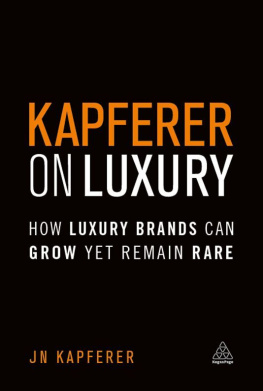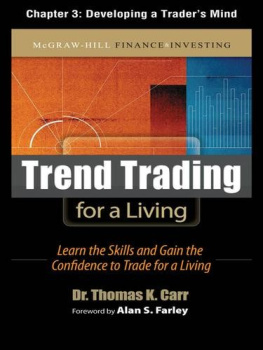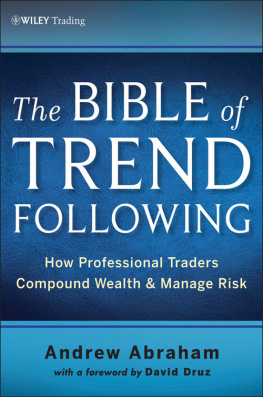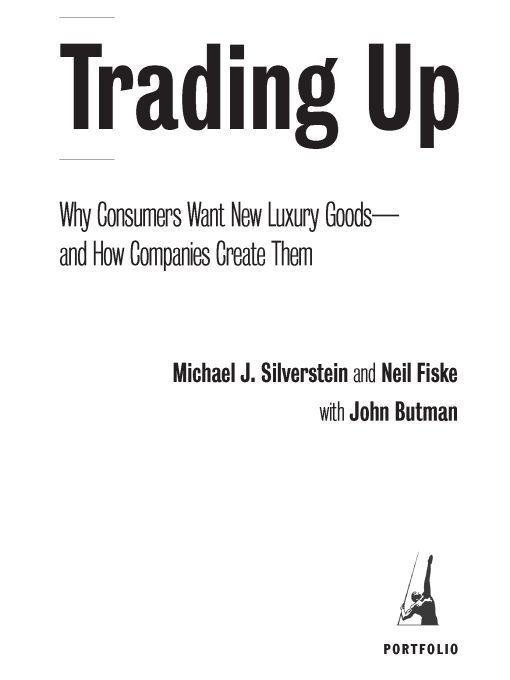Table of Contents
PORTFOLIO TRADING UP
Michael J. Silverstein is senior partner and managing director at The Boston Consulting Group. He is also coauthor of Treasure Hunt: Inside the Mind of the New Consumer. He is a member of the firms Executive Committee. He led the firms consumer and retail practice for a decade.
Neil Fiske, formerly a partner at BCG, is CEO of Eddie Bauer and now applying the rules of Trading Up in a $2 billion retail business.
Collaborating writer John Butman is the author, editor, or collaborating writer of a dozen books on themes of business management and social change. His works have been translated into fifteen languages and have appeared on the bestseller lists of The New York Times, BusinessWeek, and The Globe and Mail.
The Boston Consulting Group is a $2+ billion, privately held management consulting firm with offices in sixty-six cities worldwide.
Visit www.bcg.com/tradingup
I am deeply grateful to my family, who gave me encouragement, amazing support, and time to write. I dedicate this book to my beautiful wife, Gerry, for her kindness and unconditional love, draft reviews, and much more, and to my fantastic children, Charlie and Heather, for their love, taste, and inspiration.
Michael
To my family.
Neil
Preface
Let me begin by saying that Im a believer in this book. Ive been practicing the principles Michael and Neil describe in it since I opened my first Limited store in Columbus, Ohio, in 1963. I know their ideas work, and I believe they define the sweet spot in virtually every significant brand success today, and will continue to do so well into the future.
A little background on my relationship with Michael, Neil, and The Boston Consulting Group (BCG). Several years ago, I could see that the business model that my colleagues and I had used so successfully for over twenty yearsa model that revolved around fast fashion, significant promotions, and dominant real estate positionswould not sustain us into the future. The future was in brands.
At that time, I had never seriously talked to any business consultant or group. A classic entrepreneur, I had relied on my instincts and the lessons of experience. But, having determined that fundamental change was a must, and looking for some outside objectivity, I met with a few of the major business consultancies. Michael Silverstein came from BCG, and I liked him immediately. He is wise, pragmatic, funny, and practical. He gets right to the heart of the issue, and he has sound business judgement. Michael brought in Neil, and theyalong with a number of other bright, energetic BCG peoplebecame solid contributing strategic partners. Our business successfully made the shift to brand, and, in 2003, Fortune named us the worlds most admired specialty retailer. Our business model works, and we continue to make progress.
One of the major reasons for our success is that we believe in the taste and good sense of the consumer. Nothing is more annoying to me than hearing a buyer say, I like it, but the customer wont. Ive been shopping the world for over forty years, and Ive never overreached our customers. They stay with you if you pay them the compliment of acknowledging their good taste. They will reach, in virtually any category, if you create demand. And the consumer is more sophisticated than ever.
In this book, youll find this truth in the story of Victorias Secret, the worlds best-known, bestselling, and most-profitable lingerie brand. Analysts thought we were crazy when we bought the business. They believed that because American women had always shopped for underwear in department stores, they always would. But I had seen women in Paris, London, Vienna, and Milan buying lingerie in marvelous little boutiques. Those women understood underwear as fashion. I was convinced that American women would, too, and I was determined to design and market a specialty lingerie boutique that would become the best in the world. Over the past twenty years, I believe weve done just that. And, as the business has grown, weve continued to increase margins by constantly presenting fresh lingerie, fashion, and beauty offerings by creating demand.
The book contains many stories of entrepreneurs and companies that have achieved success with a philosophy similar to my own. I found myself imagining that Howard Schultz of Starbucks had been sitting in the same Italian coffee shop where I had sat many years ago, thinking as I had thought, This is great. Theyd love this in America. His insight was about coffee. Mine was about lingerie.
We were both right. American consumers do love wonderful goods and will pay a premium to buy them. Theyll trade up. All you have to do is give them the opportunity.
Leslie H. Wexner
Chairman and CEO
Limited Brands
Introduction to the Paperback Edition
We wrote Trading Up in 2002 and the hardcover edition was published in the fall of 2003. It was a time when the United States was preparing for, and then conducting, war in Iraq. One of my partners at The Boston Consulting Group (BCG) called me during that period and said, Michael, do you really think this trading-up phenomenon is going to last? The world is in crisis. I replied, Trading up is one of the most powerful and durable economic phenomena of our times.
Even then, as we were entering this period of great change and disruption, we were certain that Americas middle-market consumers would continue to pick one, two, or three categories of goods in which they would distort their spending to a higher percentage of their disposable incomes than one might expect.
As much as we believed in the phenomenon, however, we were a little cautious in predicting what would happen over the next five years. In fact, we were in for some big surprises about just how much the phenomenon would grow and how intense the movement (we didnt call it a fad) would become. We couldnt predict, for example:
The buoyancy of spending. We were surprised by how people continued to spend on premium goods, no matter what was happening in the political, economic, or social environment.
The lack of dependency on housing value increases. Many observers argued that trading up was largely fueled by an unsustainable increase in housing prices. But even when housing valuations took a hit, trading up continued.
Continued real income growth based on education. There is a direct correlation between education level and income. Trading-up consumers tend to be well-educated and, thus, command higher incomes and maintain higher spending levels. They protect the luxury items in their household budget so they always have a taste of the good life, but they also are able to save some money every month.
The ferocity with which women drove and defined the market, propelled by education and earning power.
The impact of younger and older consumers on trading up. Teenagers who have as much as $600 a month to spend on whatever pleases them, and baby boomers whose wealth is increasing and expenses are decreasing, are big trading-up consumers.
Underlying it all was the pull of the four emotional forcesthe need to take care of me, to connect, to quest, and to seek individual stylethat have become the siren songs for so many. Trading up, as the world came to understand, is not about wanton self-indulgence, materialist lust, or thoughtless consumerism. It is about consumers buying a few goods that make a difference in their lives.












